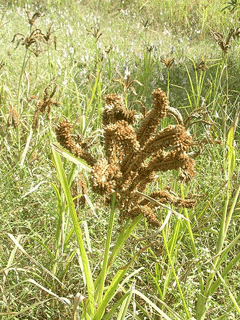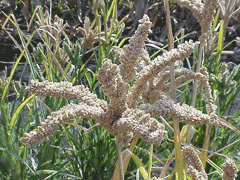 |
|
http://commons.wikimedia.org/wiki/User:Shyamal |
 |
| J. Wilson, USDA-ARS while in Ethiopia in 2002. Image in public domain and not copyrightable. |
Translate this page:
Summary
Physical Characteristics

 Eleusine coracana is a ANNUAL growing to 0.3 m (1ft).
Eleusine coracana is a ANNUAL growing to 0.3 m (1ft).
See above for USDA hardiness. It is hardy to UK zone 9. It is in flower from July to August, and the seeds ripen from August to October. The species is monoecious (individual flowers are either male or female, but both sexes can be found on the same plant) and is pollinated by Wind. The plant is self-fertile.
Suitable for: light (sandy), medium (loamy) and heavy (clay) soils, prefers well-drained soil and can grow in nutritionally poor soil. Suitable pH: mildly acid, neutral and basic (mildly alkaline) soils and can grow in saline soils.
It cannot grow in the shade. It prefers moist soil.
UK Hardiness Map
US Hardiness Map
Synonyms
Plant Habitats
Cultivated Beds;
Edible Uses
Edible Parts: Seed
Edible Uses:
Seed - cooked. Used as a millet, the seed can be cooked whole or ground and used as a flour[183]. It is used in cakes, puddings, porridge etc[1, 2, 46, 171, 183]. The flour makes a very fair unleavened bread if it is first soaked overnight in water[2]. It is often used in making fermented foods[183]. Finger millet is the main food grain for many peoples, especially in dry areas of India, Nepal and Sri Lanka[269, 272]. The grain is higher in protein, fat and minerals than rice, corn, or sorghum[269]. When consumed as food it provides a sustaining diet, especially for people doing hard work[269]. The grain may also be malted and a flour of the malted grain used as a nourishing food for infants and invalids[269]. Finger millet is considered an especially wholesome food for diabetics[269]. The seed is about 2mm in diameter[2]. A nutritional analysis is available[218]. Seed yield is about 5 Tonnes per hectare[269]. Ragi grain possesses excellent storage properties and is said to improve in quality with storage. Seed can be stored without damage for as long as 50 years[269]. They are highly valued as a reserve food in times of famine. Yield depends on variety and is directly related to duration, height and tillering capacity of type grown. Types with straight spikes give better yields than those with curved spikes[269].
References More on Edible Uses
| Composition
|
| Figures in grams (g) or miligrams (mg) per 100g of food.
|
|
|
Seed (Dry weight)
|
|
- 370 Calories per 100g
- Water : 0%
- Protein: 7.6g; Fat: 1.5g; Carbohydrate: 88g; Fibre: 3g; Ash: 2.7g;
- Minerals - Calcium: 410mg; Phosphorus: 290mg; Iron: 12.6mg; Magnesium: 0mg; Sodium: 0mg; Potassium: 0mg; Zinc: 0mg;
- Vitamins - A: 0.48mg; Thiamine (B1): 0.33mg; Riboflavin (B2): 0.11mg; Niacin: 1.2mg; B6: 0mg; C: 0mg;
- Reference: [ 218]
- Notes: The figures given here are the median of a range given in the report.
|
|
Medicinal Uses
Plants For A Future can not take any responsibility for any adverse effects from the use of plants. Always seek advice from a professional before using a plant medicinally.
Astringent Febrifuge Leprosy Tonic
The seed is astringent, tonic and cooling[240]. It is used in the treatment of fevers, biliousness and hepatitis[218, 240]. The leaf juice has been given to women in childbirth, and the plant is reported to be diaphoretic, diuretic, and vermifuge[269]. The plant is a folk remedy for treating leprosy, liver disease, measles, pleurisy, pneumonia, and small pox[269].
References More on Medicinal Uses
The Bookshop: Edible Plant Books
Our Latest books on Perennial Plants For Food Forests and Permaculture Gardens in paperback or digital formats.

Edible Tropical Plants
Food Forest Plants for Hotter Conditions: 250+ Plants For Tropical Food Forests & Permaculture Gardens.
More

Edible Temperate Plants
Plants for Your Food Forest: 500 Plants for Temperate Food Forests & Permaculture Gardens.
More

More Books
PFAF have eight books available in paperback and digital formats. Browse the shop for more information.
Shop Now
Other Uses
References More on Other Uses
Cultivation details
An easily grown plant, it succeeds in ordinary garden soil in a sunny position[200]. Tolerates moderately moist conditions[57]. Finger millet is reported to tolerate an annual precipitation of 29 to 429cm, an annual temperature range of 11.1 to 27.4°C and a pH in the range of 5.0 to 8.2[269]. Typically a tropical crop, one of the best suited for dry farming, generally grown rainfed. It thrives under a medium rainfall, on porous soils that do not get waterlogged. With rainfall of 53-75 cm, it is cultivated rainfed; with less, it is irrigated[269]. Finger millet is very adaptable and thrives at higher elevations than most other tropical cereals[269]. Cultivated on soils ranging from rich loams to poor shallow upland soils. In India, grown on black cotton soils, but thrives on red lateritic loams. Ragi stands salinity better than most cereals[269]. Finger millet is much cultivated in tropical countries for its edible seed[1, 2, 162]. Over 20 varieties of ragi are cultivated in India[183, 269]. The numerous races under cultivation are primarily divided into purple and green types; those with straight or open spikes, encurved or closed spikes, or branched spikes; length of earheads (5-10 cm long); colour of seeds (deep brown to shade of orange-red to almost white or black); dwarf in habit (45 cm tall) to up to 1.3 m tall; poor tillering to profuse tillering; early or late maturing; suitable for growing under irrigation to growing in dry areas. Many named cultivars are involved in breeding trials in India. Most improvement is sought in increasing yields, resistance to lodging, even maturity and loose panicle[269]. The plant requires a good summer if it is to do well in Britain[K], though in warmer climes it is heavy yielding, even on poor soils[57, 171]. Plants are seldom troubled by insect pests[61, 171]. The seed stores well[171]. Plants are mainly self-fertile[269].
References Carbon Farming Information and Carbon Sequestration Information
Temperature Converter
Type a value in the Celsius field to convert the value to Fahrenheit:
Fahrenheit:
The PFAF Bookshop
Plants For A Future have a number of books available in paperback and digital form. Book titles include Edible Plants, Edible Perennials, Edible Trees,Edible Shrubs, Woodland Gardening, and Temperate Food Forest Plants. Our new book is Food Forest Plants For Hotter Conditions (Tropical and Sub-Tropical).
Shop Now
Plant Propagation
Seed - sow early spring in a greenhouse and only just cover the seed. Germination should take place within 2 weeks. Prick out the seedlings into individual pots as soon as they are large enough to handle and plant them out in late spring after the last expected frosts[162, 200]. The seed can also be sown in mid to late spring in situ[200], though if the summer is cool it might not ripen its seed[K].
Other Names
If available other names are mentioned here
Native Plant Search
Search over 900 plants ideal for food forests and permaculture gardens. Filter to search native plants to your area. The plants selected are the plants in our book 'Plants For Your Food Forest: 500 Plants for Temperate Food Forests and Permaculture Gardens, as well as plants chosen for our forthcoming related books for Tropical/Hot Wet Climates and Mediterranean/Hot Dry Climates. Native Plant Search
Found In
Countries where the plant has been found are listed here if the information is available
Weed Potential
Right plant wrong place. We are currently updating this section.
Please note that a plant may be invasive in one area but may not in your area so it’s worth checking.
Conservation Status
IUCN Red List of Threatened Plants Status :

Growth: S = slow M = medium F = fast. Soil: L = light (sandy) M = medium H = heavy (clay). pH: A = acid N = neutral B = basic (alkaline). Shade: F = full shade S = semi-shade N = no shade. Moisture: D = dry M = Moist We = wet Wa = water.

Expert comment
Author
(L.)Gaertn.
Botanical References
200
Links / References
For a list of references used on this page please go here
Readers comment